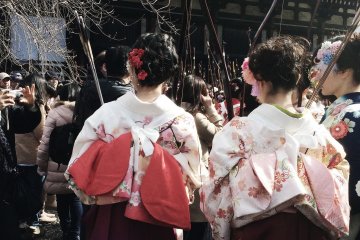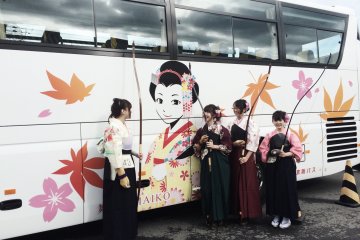It is not often you would see 20 year old women decked in colourful kimonos participating in an archery competition.
In Kyoto, this is a yearly affair of the Oh-mato Taikai, also known as the Festival of the Great Target. Oh-mato Taikai is held in conjunction with the Coming of Age Ceremony, whereby 20 year old women from all over the country gather to celebrate adulthood.
Held on the west veranda of Sanjūsangen-dō (三十三間堂), this 400 year old tradition encapsulates the spirit of reverence and wonder. Traditionally, Oh-mato Taikai is meant to display to young participants the patience and self-control required of an adult's life. The festival is a lively one, attracting both Japanese and non-Japanese crowds. Visitors are greeted with a stretch of food stalls selling a selection of Japanese street food ranging from taiyaki, karaage, and long sticks of sugared sweet potato. Families gather all around, snapping pictures of their daughters dressed to the nines in their furisode kimonos. The festival also piques the interests of many foreigners, who come to witness this iconic festival. Oh-mato Taikai has its origins in the Edo period, when a samurai named Asaoka Heibei was said to have shot 51 consecutive arrows down the veranda of the temple.
Rows of women stand in front of the veranda, waiting for their turn to have a go at drawing their bow. The targets are set 60 meters away, half the length of the temple. Each archer has a number attached to the bottom right of their ohashori, tucked under their obi. They wait for their numbers to be called, before proceeding to stand in a horizontal line. The archers shoot in groups of 11 with only 4 targets. Each archer is allowed two arrows and two minutes.
Each shot is carried out with utmost seriousness, the archer's eyes set for the prize. It is however, difficult to hit the bulls eye, with many helpers scurrying to pick up the arrows that drop on the floor at the end of the veranda. This practice is done each time a round of shooting is done, before the next row of 11 take their positions.
While waiting for competition to start, one could make a visit to the temple hall, housing one thousand life-sized statues of the Thousand Armed Kannon. These statues were intricately carved and plated with gold leaf in the 12th and 13th centuries, with over 100 of them having survived a fire, while the rest were carved again. After walking past the Kannons, you would arrive at a conjoining hall exhibiting historical objects including arrows and swords dating back to the Edo period. Nearing the exit of this hall, a Buddhist monk will carry out a ritual, praying for your health in the New Year. Using a willow branch, the monk is raised to a platform, sprinkling purified water over visitors as they leave the hall.
Oh-mato Taikai attracts around 2,000 participants annually. Other than waiting for an hour to see the actual shooting (a throng of spectators had gathered at the side of the veranda, blocking the competition from view), Oh-mato Taikai is impressive, culturally and historically intertwined in Japan's traditions and past.
Oh-mato Taikai is held in the beginning of the year, mid January. Admission to the temple is free on this date.










